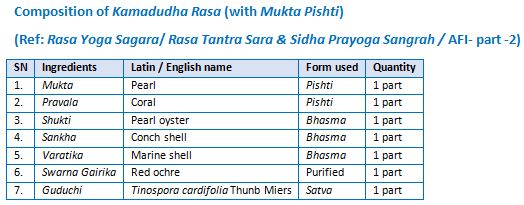Scientific explanation of mode of action of Kamadudha Rasa in Amlapitta with special reference to Acid Peptic Disorders: A Review
DOI:
https://doi.org/10.21760/jaims.8.4.17Keywords:
Kamadudha Rasa, Amlapitta, Rasaushadhis, Peptic Ulcer Disease, Anti-Ulcer ActivityAbstract
Amlapitta, also known as hyperacidity, is an illness that has been around for a while and is still very prevalent today. It is a very troublesome illness that, if left untreated, can result in a number of severe issues. Amlapitta symptoms and signs closely resemble gastritis or hyperacidity. The body's Pitta Dosha becoming more active is the primary contributor to hyperacidity. The Ayurvedic humour of Pitta represents heat or flames. There are a variety of factors that can aggravate Pitta, but the major ones are eating foods that are unsuitable for the body type or foods that shouldn't be consumed together (such as milk and fish or milk and salt), as well as drinking overly sour or spicy foods and liquids. In Ayurveda, hyperacidity is referred to as Amlapitta. Thus, a situation known as hyperacidity is one in which the body becomes more hot and sour. Pitta imbalances the digestive fire, resulting in poor food digestion and the creation of Ama. An essential medication used in Amlapitta is Kamadudha Rasa. We are attempting to provide a scientifically sound explanation of the drug's mechanism of action in this review paper.
Downloads
References
K Rama Chandra Reddy. Ocean of Ayurveda pharmaceutics. Chaukhambha Sanskrit Varanasi (chapter 1,pp-1)
Pharmaceutico Experimental study on certain formulations with special references to gastric antisecretory and anti-ulcer activity by Dr. Jagadeesh G. Mitti, Dr. K. Shankar Rao. A dissertation submitted to the Rajasthan Ayurveda University, Jodhpur. (2010)
Shastri.S, Vidyotini hindi commentary on Madhav Nidan of Madhavakar, Part 1 Chaukambha Bhawan Sanskrit Bhawan, Varanasi, edition 2004,170-172
Kuntal G, Bhagel S.M. Review of clinical observational studies conducted on 1812 patients of Amlapitta at IPGT&RA Jamnagar. IJRAP,5,1410-141, 2011.
Susharshan Shastri Madhava Nidana of Madhavakar, Amlapitta Niadanam, Shloka (2-12) ,Vijaya Rakshit and Kanthgat Chaukabha Sanskrit Sansthan,Varansi edition 2004(170-172)
Hasler, Willium.L. 2005, nausea vomiting and indigestion harrisons principles of internal medicine, MC grawhill medical publishing division 16 edition 219-224
Ayurvedic Formulary of India,- Part-2, second revised English edition, Govt. of India ministry of health and family welfare Dept. of Indian system of medicine and Homoeopathy, New Delhi-2003.
Rasa Tantra Sara & Sidha Prayoga Sangrah/Krishna Gopal Ayurveda Bhawan (Dharmarth Trust)/21st publication/year2012 Kharaliya Kasayan 80
Hirschowitz BI, Keeling D, Lewin M, Okabe S, Parsons M, Sewing K, Wallmark B, Sachs G, Pharmacological aspects of acid secretion, Dig Dis Sci. 1995 Feb; 40:3S-23S
Schubert ML, Peura DA, Control of gastric acid secretion in health and disease. Gastroenterology. 2008 Jun; 134(7):1842- 60
Schubert ML, Peura DA, Control of gastric acid secretion in health and disease. Gastroenterology. 2008 Jun; 134(7):1842- 60
Maton PN, Burton ME. Antacids revisited: a review of their clinical pharmacology and recommended therapeutic use. Drugs. 1999; 57:855–870
Vaidya Pandit Hariprapannaji, Rasayogasagara, 7 th edition, Varanasi, Krishnadas Academy Publication, 1999, Vol-I, Shloka 702-706, page-260.
Vaidya Pandit Hariprapannaji, Rasayogasagara, 7 th edition, Varanasi, Krishnadas Academy Publication, 1999, Vol-I, Shloka 707-710, page-260
Vaidya Yadavaji Trikamji Acharya,Rasamritam, English translation by Dr.Damodar Joshi and Dr.G.Prabhakar Rao, 2nd Edition, Varanasi, Chaukhambha Sanskrit Bhawan, 2003, 5th Chapter, Shloka 22-24, page-176
Vaidya Pandit Hariprapannaji, Rasayogasagar, 7 th edition, Varanasi, Krishnadas Academy Publication, 1999, Vol-I, Shloka 711-713, page-260
Vaidya Shamrao Dhonodopant Kulkarni, Ayurvediya Rasaaushadhi Nirman, First Edition, Ch 8 p.243-244, Continental Prakashan Vijay Nagar Colony, Pune, 1981.
Vaidya Shamrao Dhonodopant Kulkarni, Ayurvediya Rasaaushadhi Nirman, First Edition, Ch 3 p.71- 73, Continental Prakashan Vijay Nagar Colony, Pune, 1981.
P.V Sharma, Dravya Guna Vidnyana, Reprint Edition Vol 2 Ch Rasayana p. 761- 763, Chaukhamba Bharti Academy, Varanasi, 2005.
Shastri A., Rasa Ratna Samucchaya of Vagbhata, 9th edition, Chaukhamba Sanskrit publication, Varanasi,1995, ch. 4/15.
Ajay Kumar and Tina Singhal. Scientific explanation of mode of action of Sutshekhar Ras in Amlapitta with special reference to acid peptic disorders: A review. Int. J. Res. Ayurveda Pharm, 2018;9(5): 47-49 http://dx.doi.org/10.7897/2277- 4343.095154.















